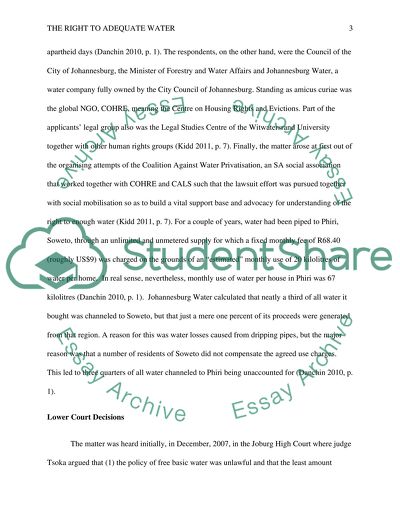Cite this document
(“The Constitutional Court of South Africa's handling of 'the right to Essay”, n.d.)
The Constitutional Court of South Africa's handling of 'the right to Essay. Retrieved from https://studentshare.org/law/1626174-the-constitutional-court-of-south-africas-handling-of-the-right-to-adequate-water-particularly-in-the-mazibuko-judgment-2009-appears-to-be-at-variance-with-un-jurisprudence-present-a-dissenting-opinion-to-that-judgment
The Constitutional Court of South Africa's handling of 'the right to Essay. Retrieved from https://studentshare.org/law/1626174-the-constitutional-court-of-south-africas-handling-of-the-right-to-adequate-water-particularly-in-the-mazibuko-judgment-2009-appears-to-be-at-variance-with-un-jurisprudence-present-a-dissenting-opinion-to-that-judgment
(The Constitutional Court of South Africa's Handling of 'The Right to Essay)
The Constitutional Court of South Africa's Handling of 'The Right to Essay. https://studentshare.org/law/1626174-the-constitutional-court-of-south-africas-handling-of-the-right-to-adequate-water-particularly-in-the-mazibuko-judgment-2009-appears-to-be-at-variance-with-un-jurisprudence-present-a-dissenting-opinion-to-that-judgment.
The Constitutional Court of South Africa's Handling of 'The Right to Essay. https://studentshare.org/law/1626174-the-constitutional-court-of-south-africas-handling-of-the-right-to-adequate-water-particularly-in-the-mazibuko-judgment-2009-appears-to-be-at-variance-with-un-jurisprudence-present-a-dissenting-opinion-to-that-judgment.
“The Constitutional Court of South Africa's Handling of 'The Right to Essay”, n.d. https://studentshare.org/law/1626174-the-constitutional-court-of-south-africas-handling-of-the-right-to-adequate-water-particularly-in-the-mazibuko-judgment-2009-appears-to-be-at-variance-with-un-jurisprudence-present-a-dissenting-opinion-to-that-judgment.


